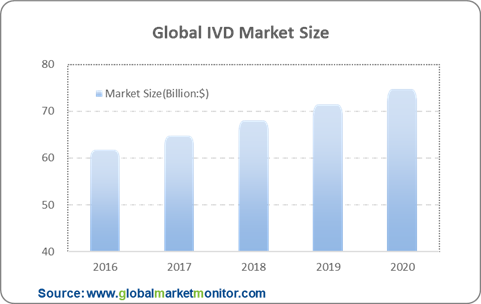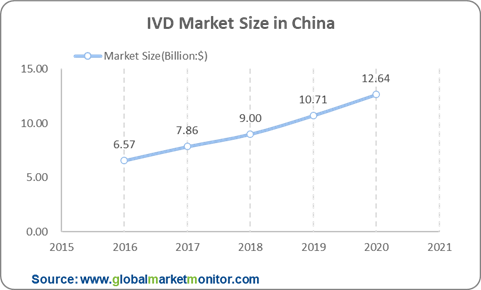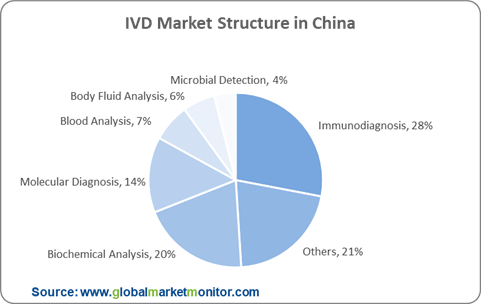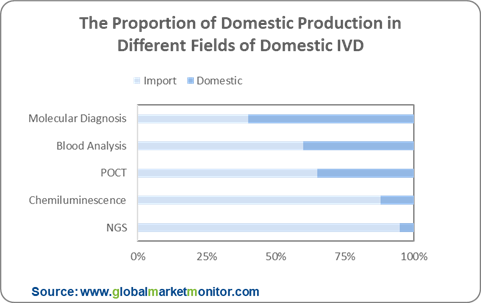IVD, an important indicator of medical technology development, is a prerequisite for diagnosis and treatment and. IVD is a product and service that uses clinical information obtained by testing human specimens outside the human body to determine body functions and diseases, known as the "doctor's eye" and is an important carrier of modern laboratory medicine. It provides most of the decision-making information for clinical diagnosis and has increasingly become an important part of the prevention, diagnosis, and treatment of human diseases. Involving multiple disciplines such as molecular biology, genetic diagnostics, and translational medicine, IVD products can be divided into biochemical diagnostics, immunological diagnostics, and molecular diagnostics, and microbiological diagnostics, and hematological diagnostics, and urine according to the different technologies used in clinical medical test items Diagnosis and other categories.
The Industrial Chain of IVD
IVD products are mainly composed of diagnostic equipment, diagnostic reagents, and related calibration products.
The upstream of IVD reagents are the main suppliers of related chemical and biological raw materials, including fine chemicals, antigens, antibodies, biological enzymes, and polymer particulate materials; the upstream of IVD instruments are mainly manufacturers of electronic devices and abrasives.
IVD products customers mainly include various medical institutions, third-party testing centers, national public health testing centers, and individuals. Among them, medical institutions account for 90% of the market share, including various hospitals, community medical service centers, township health centers, physical examination centers, in which hospitals are the main market for in vitro testing reagents.
Global IVD Market with Steady Growth

Domestic IVD Market with Rapid Growth but at a Lower Localization Rate


Larger Opportunities for Domestic Substitution
IVD industry in China has achieved most of the localization in the low-end technology fields, such as enzyme immunoassay technology and clinical biochemical diagnosis technology, while in the high-end technology fields, such as chemiluminescence detection and POCT, most of the markets are still occupied by foreign capital.

The IVD Market Has Great Room for Growth as the Domestic Per Capita IVD Expenditure Is Low
The data shows that per capita IVD expenditure of China in 2019 is about 7.65 billion US dollars, far lower than that of the global level of 10.67 US dollars, let alone the developed countries such as Europe, America, and Japan. With the improvement of the domestic economic development level and the improvement of people's ability to pay, there is huge room for the future development of the IVD industry.
Molecular Diagnostics: The Golden Track of IVD
Molecular diagnosis is the application of molecular biology methods to detect changes in the structure or expression level of genetic material to make a diagnosis. Relevant data shows that the size of the molecular diagnostics market in China in 2019 was 11.58 billion yuan, an increase of 10.7%, which is expected to reach 14.05 billion yuan in 2020.
Both Demand and Supply Are Both in Encouragement. Throughout the entire molecular diagnostic industry chain, upstream instruments are the focus of the industry, and investment institutions have paid a lot of attention. At present, domestic innovation and breakthroughs have been achieved in the third and fourth generation gene sequencing, digital PCR, and other technical fields. The sequencing results are not inferior to foreign countries and will be further imported in the future. Substitution will be the general trend.
Midstream service providers and ICL have ushered in unprecedented rapid development in the past 10 years. But compared with upstream and downstream, the bargaining power of midstream is weak. Companies with unique product pipelines and strong channel capabilities can win by surprise.
The downstream demand continues to be strong, and scientific research and clinical research and development continue to drive the development of upstream instruments and midstream reagents.
From January to July 2020, a total of 29 financing incidents occurred on the molecular diagnostic circuit, accounting for 70% of the entire IVD circuit. From the perspective of the amount of financing, there were 9 cases where a single financing amount exceeded 100 million yuan, and MGI broke the record for the largest single-round financing of domestic gene sequencing with 1 billion US dollars. A total of 78 investment institutions entered the market, of which Qiming Ventures made 3 shots and participated in New Horizon Health D and E rounds, and Tisenc Medical B round financing.
POCT: The Emerging Track of IVD
There are two lines in the development of the domestic inspection industry. One is highly automated inspection equipment, which is what we often call big light, such as high-speed inspection equipment, fully automated assembly lines. The main customer groups are domestic third and second levels in hospitals. There are more than 2,000 top large hospitals across the country, accounting for less than 0.3% of the total number of medical institutions, but they have to undertake one-fifth of the domestic diagnosis and treatment volume. The basic board of large hospitals determines the direction of their procurement of inspection equipment to pursue accuracy and stability.
The second is the miniaturization of equipment, which is represented by POCT equipment. Its main customer groups are not only grassroots hospitals and clinics, but also law enforcement agencies and individual families. POCT refers to a detection method that is carried out at the sampling site and uses portable analytical instruments and supporting reagents to quickly obtain detection results. It is currently small in scale and under rapid development, with a growth rate of over 20%. Compared with traditional IVD, POCT has the characteristics of simplicity and timeliness. This feature determines the wide distribution of product consumers, a large number, and large differences in product demand. From the perspective of the medical reform trend, the state is working hard to regulate and flatten the current allocation structure of medical resources characterized by an inverted triangle. Through this process will be relatively long, POCT companies that conform to the trend of medical reform can benefit from it.
Custom Reporting
https://www.globalmarketmonitor.com/request.php?type=9&rid=0
We provide more professional and intelligent market reports to complement your business decisions.